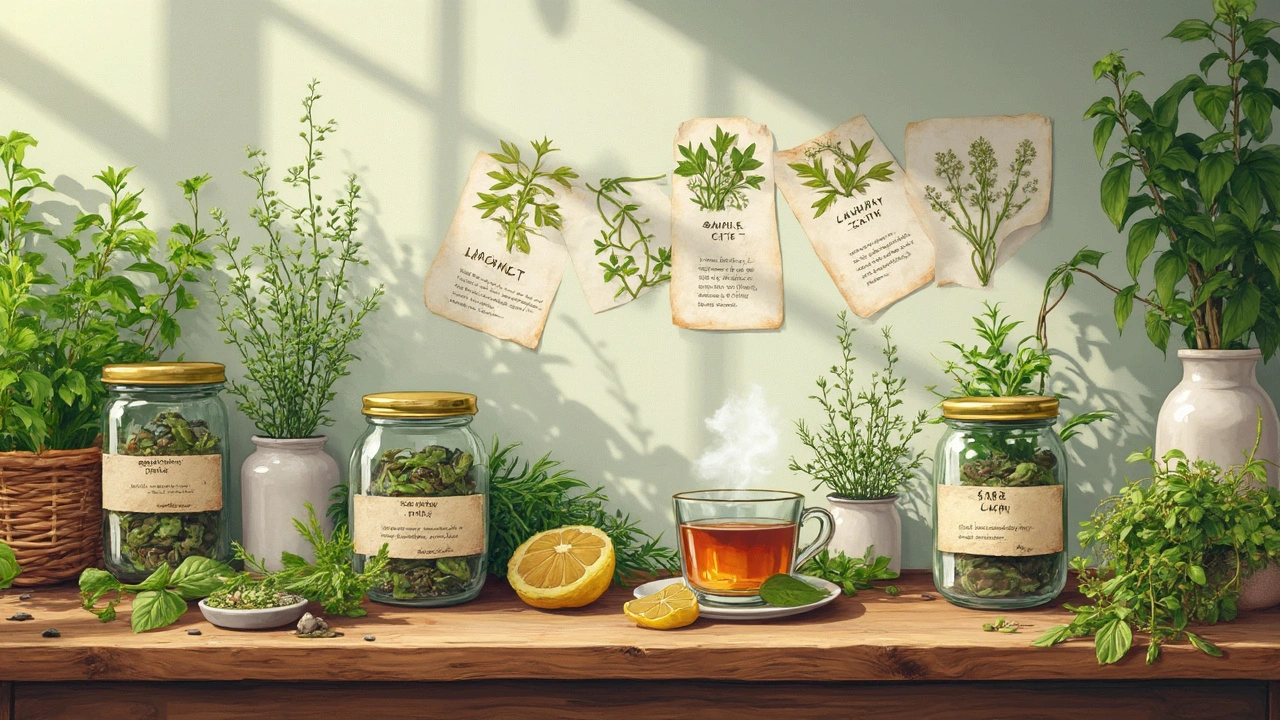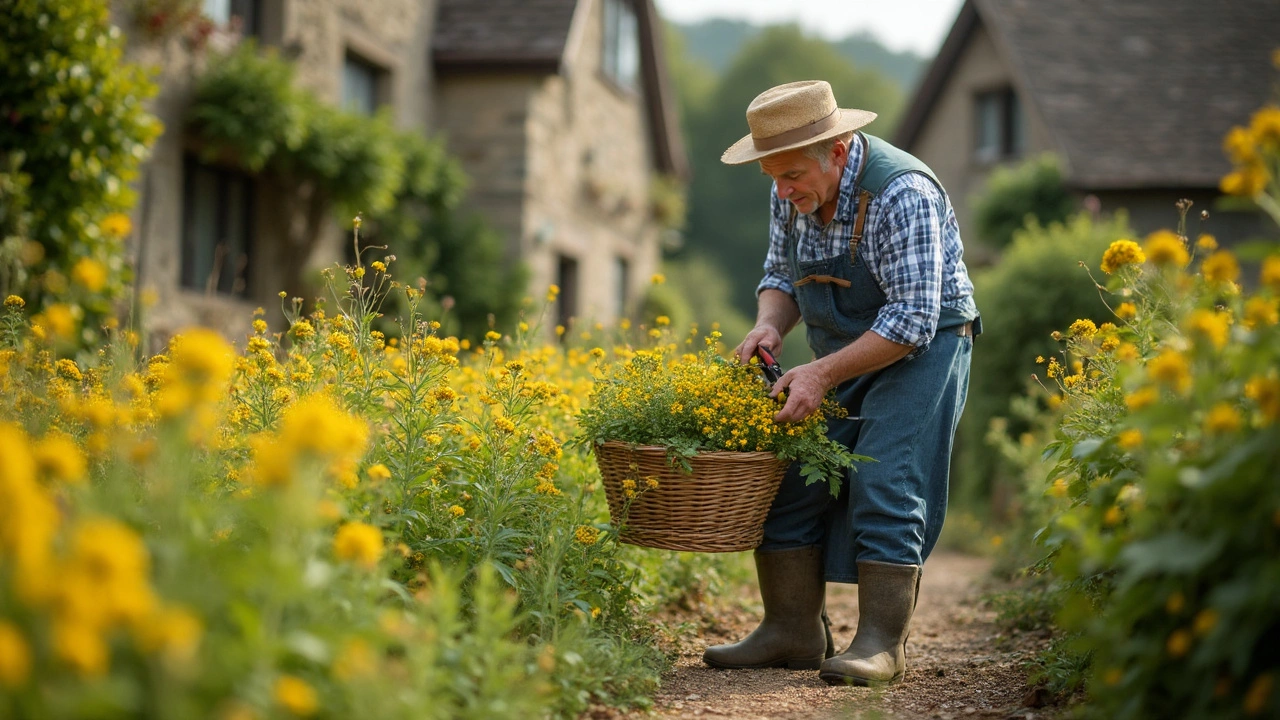Planting and Growing Tansy: Responsible Beginnings
Imagine a patch of bold, fern-like greens waving under summer sun—tansy. You’ll never forget its spicy, almost citrusy scent. Growing tansy can make you feel like a botanist and a little bit of a rebel at the same time. This herb gets a bad rap as an invasive plant, but grown with some care and boundaries, it can be downright charming and useful. Here’s the thing: tansy is tough. It loves neglect, thrives in poor soils, and barely flinches at drought. But it also spreads like it’s auditioning for a marathon, so you want to give it a controlled spot. I grow mine behind our garage, fenced off with bricks (Lachlan once called it the “herb prison”).
If you want the best-tasting and most potent tansy for tea, pick a sunny spot with quick-draining soil. Raised beds or big containers work like a charm. Seeds go straight into the dirt after the last frost—scatter lightly, press into the earth, don’t bother burying them deep. Within two weeks, you’ll notice tiny, jagged seedlings. Thin the babies out so they have space to branch and breathe. They’ll thank you by shooting up strong and lush, sometimes up to four feet tall by midsummer. If you’re thinking of including tansy in your perennial garden, plant it near your compost or at the edge of your veg patch. Some gardeners even use it as a companion plant—its strong aroma confuses pests like ants and flies (honestly, I’d plant it for that alone). Just keep it away from edible crops you plan to harvest straight for dinner because it can be mildly toxic in big doses, especially for kids or curious pets—Lachlan once tried to “decorate” our salad, lesson learned!
Tansy’s narrow, bright-yellow flowers are hard to miss in July and August. While they look like little buttons, tea drinkers want the leaves. It’s best to harvest leaves right after the flower buds appear but before full blooming, around mid-morning—this is when the oils are strongest and the bitterness isn’t overwhelming. Snip with clean garden scissors, never pulling by hand (you’ll risk damaging the plant). And please, always leave about half the plant standing to keep it healthy for next year’s harvest—responsible picking matters here.
Not everyone knows that tansy’s name comes from the Greek “Athanaton,” meaning immortal. People used to tuck it in coffins, hoping its intense smell would slow down decay. Not exactly charming at tea parties, but fascinating. Today, we just want vibrant greens, fresh and ready for the next step.

Drying Tansy Leaves for the Perfect Brew
Caught in the kitchen with a pile of fresh tansy, it does look a bit like a wild forager’s dream. But don’t rush—the way you dry those leaves will decide how your tea tastes. First rule: never use the oven or microwave. Heat destroys the essential oils, turning your brew bland and medicinal. Instead, bunch the stems loosely and tie with kitchen twine, then hang them upside-down in a dry, dark, airy room. The attic works for me. If you’re short on space, you can spread the leaves over a mesh rack or screen—just make sure the air can circulate everywhere. Flip them every day or so to make sure all sides get even drying.
Give it about ten to fourteen days—sometimes less if you’re lucky with the weather. You know you’re done when the leaves snap crisply between your fingers and crumble to dust with a squeeze. If there’s any bend left, wait. Damp tansy molds quickly, and you don’t want your stash ruined. Some folks use small fans to speed up dry time without raising the temperature. It feels high-tech, but it does help, especially in humid climates.
Here’s something most people miss: always strip the leaves off the stems before storing (it’s like shelling peas, oddly satisfying). Stems tend to hold moisture and can make storage messier than it needs to be. I store mine in glass jars—dark ones if I have them, or clear jars tucked inside a cupboard. Never use plastic containers; tansy’s oils will stick, leaving behind that weird floral flavor in anything you put in next, even cookies. Label each jar with the date and spot in the garden where it grew. Batch-to-batch flavor can change—my southern patch is spicier than the north-facing crop.
If you want to go full tradition, you can layer your leaves with rice or silica packets during drying to combat excess moisture. Just remember to remove them before brewing. Got lots of leaves? You can grind some into a fine powder for sprinkling in DIY herbal blends. Not feeling crafty? Loose leaves last longer anyway. Store away from heat, sun, or moisture, and your dried tansy will keep up to a year, although I like to use it up by the next harvest. The fresher, the better—for aroma, flavor, and all the benefits you want out of each cup.

Storing and Brewing Tansy Safely: From Jar to Cup
So you have a jar packed with dried tansy leaves—what now? Brewing tansy tea isn’t like your homestyle chamomile. Tansy has a bold, slightly bitter taste, and needs respect in the pot. If you’re new to it, start with just half a teaspoon of leaves per cup. Pour boiling water over the leaves and cover your mug—covering is key, since you want to keep those essential oils from escaping. Steep for about six to eight minutes; going longer just pulls out extra bitterness. Strain thoroughly, and don’t be shocked by the color—it’ll be somewhere between deep green and amber.
Tansy is potent; that’s why responsible use is always talked about (I only brew it for adults at home, never for Lachlan—this one’s a “mom mug”). If you’re curious about more of the tansy tea health benefits, it’s worth checking out studies highlighting everything from digestive support to possible antioxidant action. Traditional wisdom often recommends tansy for things like easing stomach cramps and even repelling pesky bugs; there’s a real science to its compounds, like thujone and camphor. But remember, moderation is non-negotiable. Too much can be toxic, especially for pregnant women, nursing moms, and kids. If in doubt, chat with your health provider.
For storage, keep your jars away from stove heat, and reseal tightly after each use. My personal tip? Toss a tiny piece of clean muslin cloth into the jar if your region has humidity trouble; it’ll soak up stray moisture. And I check all my jars monthly. Any sign of mold or a musty smell—out it goes, no questions. Using up tansy within the year is smartest. If you want variety, mix a pinch of dried tansy with mint, lemon balm, or a hint of licorice root to round out occasional bitterness. Plenty of herbalists swear by those combos for a more balanced, sippable tea.
I sometimes get asked if you can use tansy leaves straight from the freezer. Technically, yes, but the flavor isn’t as strong, and you lose a little of those famous essential oils. Drying, storing, and brewing carefully covers all the bases for both flavor and safety. And if you’re using homegrown tansy, you know exactly what’s in your cup—no mystery additives, no weird aftertastes. Just classic, old-world herbal know-how, right from the garden to your teacup.


pooja shukla
Honestly, if you haven’t tried growing tansy yet, you’re seriously missing out! This herb is not just some random garden plant; it’s been a powerhouse in traditional medicine and folk remedies, especially in places like India where herbal knowledge is deep-rooted.
The article’s tips about harvesting responsibly are crucial because tansy can be pretty invasive if you don’t keep an eye on it. Also, drying and storing it correctly makes all the difference in retaining its benefits — something many people overlook.
Plus, the fact that tansy supports wellness routines beyond just tea? That’s not common knowledge, folks! From natural insect repellent properties to digestive aid, this plant is a gem. Honestly, I’m surprised it isn’t mainstream yet.
Seriously, gardeners and wellness enthusiasts should give this a shot. With all the synthetic stuff out there, going natural and trying out herbs like tansy feels like a patriotic act—supporting our roots and natural remedies.
Anyone else here growing it? What’s your experience been like, especially the taste of the tea? Would love to compare notes!
Poonam Mali
Oh please, let’s not romanticize this plant without considering the whole picture. Tansy isn’t some magical cure-all like some would have you believe. It contains thujone, a compound that, in high doses, is actually toxic and can cause serious side effects. So, glorifying it without emphasizing these risks is irresponsible at best.
This 'often-misunderstood herb' narrative feels like a thin veil for promoting potentially dangerous usage. Gardeners should be wary and not just blindly follow advice that glosses over the toxicology.
The article’s tone, while informative, dances around these important caveats. Responsible handling should mean more than just 'safe preparation instructions'; it should highlight the dangers prominently.
We need to be clear-eyed about what we encourage, especially when people might try to self-medicate. Herbalism is nuanced, and not everything natural is safe.
Does anyone else here prioritize scientific rigor when discussing herbal remedies? Because I find sweeping generalizations very problematic.
Alan Whittaker
Hold on just a minute. I can’t help but be suspicious about all these glowing promotions of tansy. Ever stop to wonder who benefits from pushing such herbs into public consciousness? There’s a whole web of corporate interests and hidden agendas behind the natural health trend.
Tansy’s thujone content has been flagged by regulatory agencies around the world for a reason, yet here we have enthusiasts and authors conveniently skipping over these facts. It reeks of misinformation, possibly amplified intentionally.
Moreover, the 'from garden to teacup' narrative feels like a subtle way to bypass pharmaceutical regulations and promote unregulated herbal products, potentially endangering users.
People trust these online articles, and with no transparency about risk management, it’s just reckless. The glorification of this herb without due caution feels like we're being nudged into untested territory for profit or ideological reasons.
Anyone else concerned about the lack of strict oversight in these herbal wellness fads? It’s a murky business, I tell you.
Michael Waddington
I’ve been growing tansy for a couple of years now, and I gotta say, the article hits some good points but misses others. Yes, it’s a tough plant to contain because it spreads quickly, so responsible harvesting is vital.
That said, before jumping on the tansy tea bandwagon, seriously consider your dosage. Too much thujone exposure ain’t no joke. It’s great for pest control and as a companion plant in the garden, but when it comes to ingestion, moderation and knowledge are key.
I appreciate the article’s practical advice on drying and storing — helps maintain potency and avoids mold.
Anyone else here experimented with different ways to use tansy? I find pairing it with other herbs can balance out the strong taste and effects.
Share your recipes and safety tips; always good to learn from fellow gardeners.
HAMZA JAAN
This whole herbal tea trend is getting out of hand, but I get it, people want natural alternatives. I tried tansy tea once, and honestly, it was quite bitter and a bit overwhelming.
These plants have benefits but also come with risks that many casual users gloss over. The article’s focus on 'supporting your wellness routine' sounds nice, but it should come with a bigger, louder disclaimer about toxicity.
How does this compare with other herbal teas like chamomile or mint, which are widely recognized as safe? Because tansy feels like walking on thin ice.
Also, for those growing it: does it attract certain pests away from other plants? I’m curious if the garden benefits justify having it around.
Would be cool if someone could post a detailed comparison of tansy’s pros and cons versus other herbs popular in teas.
April Rios
Tansy is fascinating in the way it blends history, botany, and wellness. I love reading about plants that bridge traditional uses with contemporary practices.
That being said, it’s crucial to approach herbs with respect and knowledge. This article does well to encourage responsible harvesting and preparation but could elaborate more on contraindications and interactions.
As a pseudo-philosopher type, I find the cultural lore around tansy compelling. It’s more than a plant; it’s a story of how humans relate to nature.
Who else thinks we should integrate more botanical education into everyday wellness advice? Imagine the kind of consciousness it would foster.
Looking forward to hearing from anyone who’s experimented with combining tansy tea with meditation or relaxation routines.
byron thierry
From a formal perspective, the article presents a commendable overview of tansy’s cultivation and usage within domestic settings. It succeeds in illustrating various beneficial aspects of the herb while outlining pertinent safety considerations.
However, an in-depth discussion concerning the pharmacological constituents of tansy, specifically the concentration limits of thujone permissible for safe ingestion, would augment its thoroughness.
Furthermore, the inclusion of more comprehensive citations from clinical studies or authoritative herbal pharmacopeias would render the advice more robust and credible to discerning readers.
Notwithstanding these points, the pragmatic instructions regarding harvesting and storage are well-articulated and likely to be of considerable utility to practitioners.
I invite others to deliberate on the integration of tansy within broader phytotherapeutic frameworks.
bob zika
While my engagement with traditional herbal uses is somewhat limited, I find this conversation stimulating and worth pursuing further. The article's guidance on growing and storing tansy is quite practical and informative.
It's an effective way to integrate time-tested botanical knowledge with contemporary usage, provided caution is maintained. It would be interesting to see more elaboration on the recommended quantities for tea preparation.
Safety should indeed be paramount; any herbal supplement or tea must encourage responsible consumption.
Others, do you have particular protocols or methods that enhance the experience or safety of tansy consumption?
Let's keep sharing our observations and insights.
M Black
Hey folks, just a quick shoutout to anyone out there who’s experimented with blends involving tansy 😄! I got into it mainly cuz I love trying new herbal concoctions, and the wellness hype caught my eye.
The drying and storage tips in the post are spot on — helps keep the flavor and benefits without that musty old-herb vibe.
But seriously, the taste is pretty bold, not your usual mild tea. So if you’re thinking of jumping in, maybe mix it up with some mint or chamomile — it mellows things out and makes it way easier to enjoy.
Also, always start small. Remember, herbal does not mean harmless 🙃. Took me a few tries to get the hang of dosing.
Anybody else have any weird combos or cool recipes? Sharing is caring!
Sidney Wachira
Wow, this thread is quite the rollercoaster! 😅 I gotta say, tansy is fascinating but definitely not for the faint of heart.
I tried making tansy tea once and nearly dramatised the whole experience — the bitterness was next-level, the effects mild but definitely noticeable. I can get why some people might swear by it, but others should approach with respect and caution.
Honestly, I’m grateful for the debates here because they highlight that herbal usage isn’t black-and-white. It’s all about knowing what you’re doing and being smart about it.
Anyone else had a 'dramatic' first experience with herbal teas? I feel like these stories are what make this community so rich and fun.
For sure gonna try some of those mixes mentioned earlier.
Julie Sook-Man Chan
I appreciate the diverse perspectives shared here. It’s clear that tansy carries both promise and caution, and it calls for thoughtful engagement.
Growing herbs organically at home connects us with nature and tradition, but we must remain mindful of constituents like thujone.
The article's balance of practical advice with wellness benefits is helpful, yet one cannot underestimate the importance of individual health variables and potential allergies.
My experience with herbs in my garden has taught me to start with small doses and observe effects carefully. This should be standard practice.
Thank you all for the stimulating dialog. It enriches our collective understanding of herbs like tansy.